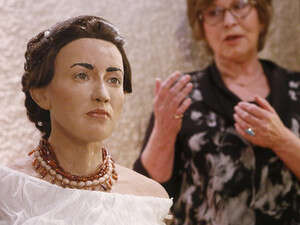What did Delilah look like?
A new NatGeo series reconstructs biblical-times skulls

"The Lost Faces of the Bible" is a new National Geographic series, whose goal is to reconstruct the faces of skulls from biblical times. The show's creator is Simcha Yaakobovich, an Emmy-winning Jewish-Canadian journalist who specializes in producing and directing documentaries. CSI star David Berman is the host of the show, which comes as no surprise since the technology used to reconstruct the faces was borrowed from the police - Where it is used to identify dead bodies.
The creators of the show used the skulls of four different people from the land of Israel: A Philistine woman, a warrior, a sacrificed baby and a Galilee man from Jesus' time. "He probably went to hear him preach", says Yaakobovich, adding that "the goal is to bring the characters from the bible back to life".
The definite star of the show is "Delilah", the name given to the skull of a Philistine woman from about the same time of Samson. "She might have been a neighbor of the actual Delilah", says Victoria Lywood, the forensic scientist in-charge of the restoration. Lywood works regularly with the Montreal police department, reconstructing skulls using soft matter. "Recreating her face and skin was quite complicated, since the police don't reconstruct skulls from thousands of years ago", she explains, "the hair and necklace were based on research done about that period".
The hardest face to recreate was the one of a 3-6 month old baby, sacrificed and buried in a jar. "I never had to recreate the skull of such a young baby", admits Lywood. The experts that helped her in the task explain that "The skull was as thin as an eggshell, which made it extremely sensitive and fragile. It was like putting a puzzle together".
The creation of the series was met with protest by religious groups. "Some Haredi groups were opposed to the usage of actual skulls", explains Yaakobovich, "but I would like to assure everyone that the skulls themselves are not a part of the reconstruction, since we used exact replicas of them - the originals were re-buried".
At the same time Lywood was reconstructing the faces by hand, a different expert used digital software to reconstruct the same skulls, and the small differences between the results are interesting: Lywood's "Delilah" is a bit lighter skinned, while the digitally recreated "Delilah" has darker skin and slantier eyes. "They are definitely similar, maybe even related", says Yaakobovich with a smile.
How objective is your work? Ater all, the two results are not identical.
Lywood: "This is definitely an approximation, based on bone structure. Reconstruction might not be exact, but there are rules". Lywood explains that even the reconstructions she creates for the Montreal police department are not always accurate: "The victim's mother might say that it doesn't look like him, but the neighbor - who doesn't remember every single facial detail - will say it's very similar".
However, the reconstruction has its downsides. "It's a bit chilling to go to sleep when a skull is right there, watching you - but you get used to it", admits Lywood.




